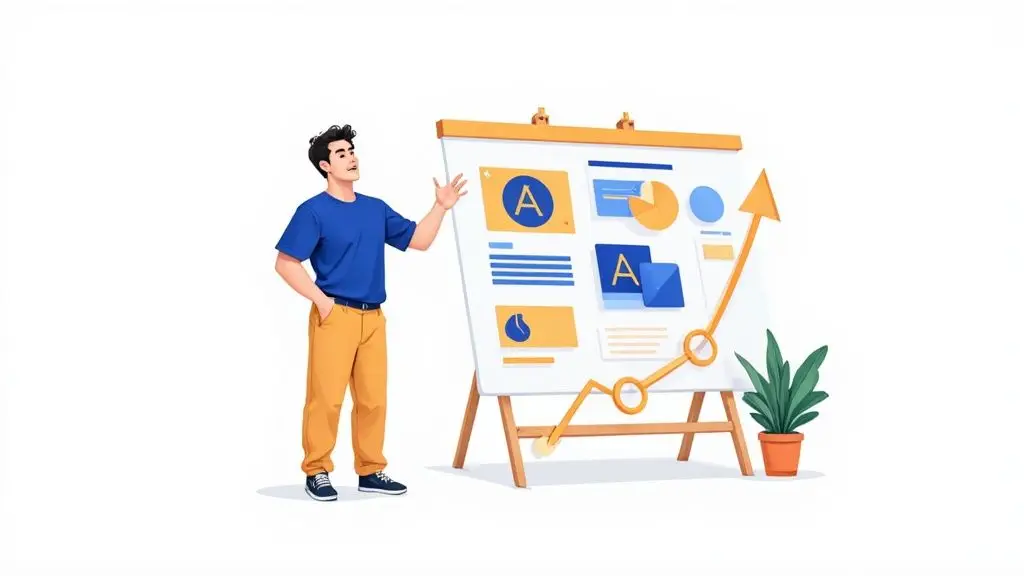Why Reinvention Matters Now More Than Ever

The world is changing rapidly, making adaptation and evolution essential for success. This goes beyond simply keeping up with trends; it's about ensuring your skills, values, and aspirations align with a world in constant motion. Reinventing yourself is no longer optional, but a necessity for navigating the complexities of modern life. This means actively pursuing opportunities to grow, learn, and redefine who you are in the context of a changing environment.
Recognizing the Need for Change
How do you know when it's time for a reinvention? Temporary setbacks can sometimes feel like they warrant a complete overhaul. However, true reinvention triggers often go much deeper. These might include a persistent sense of unfulfillment, a feeling that your talents aren't being fully utilized, or a growing misalignment between your current path and your long-term aspirations. These aren't fleeting feelings, but persistent signals guiding you towards a more authentic and fulfilling life. The first step is distinguishing between temporary dissatisfaction and a genuine need for transformation.
The Psychology of Reinvention
True reinvention isn't just about changing external factors; it's also about shifting your internal perspective. This involves understanding the psychology of change. It requires self-awareness, a willingness to challenge established beliefs, and the courage to step outside your comfort zone. Think of a caterpillar transforming into a butterfly. The process is challenging and requires complete surrender to the unknown, but the result is a profound metamorphosis. Similarly, personal reinvention requires embracing the discomfort of growth and trusting in the possibility of a more rewarding future.
External Forces Driving Reinvention
The external world plays a significant role in our need for reinvention. Technological progress, economic shifts, and societal changes can disrupt entire industries, redefine career paths, and challenge our current skill sets. This constant state of change can be intimidating, but it also creates opportunities for those who are willing to adapt. For example, the rise of artificial intelligence is reshaping many professions, presenting both challenges and opportunities for individuals to upskill and redefine their roles. This emphasizes the importance of continuous learning and adaptation. Even well-established businesses are embracing change.
Reinvention efforts among CEOs have increased significantly. A PwC survey from 2025 found that nearly 60% of CEOs anticipated global economic growth in the next 12 months, up from 38% the previous year and 18% two years prior. This optimism is driving various reinvention strategies, with product and service innovation being a primary focus. However, only about 7% of companies' revenue comes from new ventures launched in the last five years, highlighting the need for more profound transformation. Companies in the Middle East and the Chinese Mainland stand out, with over 10% of revenue coming from new ventures. Ultimately, embracing reinvention allows you not only to survive change, but to thrive in the face of new possibilities. This proactive approach empowers you to shape your future, rather than being controlled by external circumstances.
Mapping Your Current Reality (With Brutal Honesty)

Before embarking on a journey of self-reinvention, it's essential to understand your starting point. This requires an honest assessment of your current reality, acknowledging both strengths and weaknesses. This isn't about self-criticism; it's about gaining clarity. Think of it like creating a blueprint before building a house. You need a clear understanding of the existing structure before designing the new one.
This section will guide you through a process of self-assessment, preparing you for a successful reinvention.
Identifying Your Core Values
Reinvention is about aligning your actions with your values. Ask yourself: what truly matters? Is it creativity, security, freedom, connection, or something else entirely? Identifying your core values helps you filter out external expectations and focus on what truly resonates with you.
This process, often used by professional coaches, can be challenging yet rewarding. For example, if you value freedom and flexibility, a traditional 9-to-5 job might not be the best fit, even if it's expected of you. This realization can guide your reinvention journey toward a more fulfilling career path.
Assessing Your Skills and Circumstances
Beyond values, understanding your existing skills and current circumstances is crucial. What are you good at? What resources are available to you? What limitations do you face?
Answering these questions honestly provides a realistic foundation for your reinvention. It's like taking inventory before starting a business. You need to know your assets before creating a viable business plan. Similarly, assessing your skills and circumstances helps you determine what's possible and what adjustments you might need to make.
Recognizing Limiting Patterns
Reinvention often involves breaking free from patterns that no longer serve you. These could be negative thoughts, unproductive habits, or limiting beliefs. Recognizing these patterns is the first step toward replacing them with more empowering ones.
For instance, if you consistently doubt your abilities, cultivating self-belief is essential before making a major career change. Addressing internal obstacles is just as important as addressing external ones. Successful reinvention requires overcoming these internal roadblocks for long-term transformation.
Utilizing a Self-Assessment Framework
To structure your self-reflection, use a self-assessment framework. This tool allows you to systematically evaluate different aspects of your life and identify areas for improvement.
To help you with this process, the table below provides a framework for self-assessment:
| Life Domain | Current Satisfaction (1-10) | Desired State | Gap Analysis | Priority Level |
|---|---|---|---|---|
| Career | 6 | Leading my own business | Need to develop entrepreneurial skills and build a network | High |
| Relationships | 8 | Deeper connections with family and friends | Invest more time and emotional energy in key relationships | Medium |
| Finances | 5 | Financial independence and security | Create a budget, reduce debt, and explore investment opportunities | High |
| Health | 7 | Improved physical fitness and energy levels | Incorporate regular exercise and healthier eating habits | Medium |
| Personal Growth | 4 | Continuously learning and expanding my horizons | Dedicate time for reading, taking courses, and exploring new interests | High |
By assigning numerical values to your satisfaction level and defining your desired state, you can pinpoint the gaps between where you are and where you want to be. This clarifies which areas need the most attention. This structured approach helps translate vague desires into actionable steps, making the process of reinvention more concrete and achievable.
Crafting Your Reinvention Blueprint That Actually Works

Successful reinvention requires a structured approach. Think of it as planning a major expedition. You wouldn't embark on a journey without a map, supplies, and a plan for potential challenges. Similarly, personal reinvention necessitates a well-defined reinvention blueprint to guide you through the complexities of transformation while keeping you focused on your goals.
Breaking Down Your Reinvention Into Achievable Milestones
Overhauling your life at once can be overwhelming. Instead, break your reinvention journey into smaller, more manageable milestones. These could involve setting short-term goals, like learning a new skill, establishing a new habit, or expanding your network.
Each milestone reached builds momentum and reinforces your commitment. For example, if you're aiming for a career change, a first milestone might be updating your resume and LinkedIn profile. This small step contributes to the larger goal and makes the process less daunting.
Identifying and Gathering Necessary Resources
Reinvention often requires resources beyond your current capabilities. This could involve financial investment, acquiring new skills, seeking mentorship, or building a supportive network. Identify these resources early and create a plan for accessing them.
This proactive approach minimizes potential roadblocks. For example, if you're reinventing your career, resources might include online courses, networking events, or career coaching services.
Anticipating Potential Obstacles and Developing Contingency Plans
Every journey has its challenges. Anticipating potential obstacles is crucial for navigating setbacks and maintaining forward motion. Develop contingency plans for common challenges, such as financial constraints, time limitations, or negative self-talk.
These plans act as a safety net, allowing you to adapt. For instance, if you're starting a new business, you might face unexpected competition. A contingency plan could involve diversifying your products or adjusting your marketing strategies.
To further understand the phases of personal reinvention, consider the following table:
The table below, "The Four Phases of Personal Reinvention," provides a detailed breakdown of the reinvention process, including key activities, common challenges, and success indicators for each phase. It also includes a typical duration for each phase, giving you a better idea of the time commitment involved.
| Phase | Key Activities | Common Challenges | Success Indicators | Typical Duration |
|---|---|---|---|---|
| Self-Assessment | Identifying strengths, weaknesses, values, and passions; exploring potential paths | Resistance to change, fear of the unknown, difficulty identifying core values | Clarity about desired changes, identification of potential paths, development of a preliminary plan | 1-3 Months |
| Exploration & Planning | Researching options, setting goals, developing a detailed action plan, acquiring necessary resources | Information overload, analysis paralysis, lack of resources | Clear goals and action plan, secured resources, growing confidence | 2-6 Months |
| Implementation & Action | Putting the plan into action, building new habits, taking consistent steps towards goals | Procrastination, self-doubt, unexpected obstacles | Tangible progress towards goals, development of new skills and habits, growing resilience | 6-12 Months |
| Refinement & Integration | Evaluating progress, adjusting the plan as needed, integrating new changes into lifestyle | Difficulty adapting to change, setbacks and challenges, maintaining motivation | Sustainable change integrated into lifestyle, achievement of desired outcomes, sense of fulfillment | Ongoing |
This table provides a framework for understanding the typical progression of personal reinvention. Remember that these durations are estimates and your individual journey may vary.
Maintaining Momentum and Adapting to Change
Maintaining momentum requires resilience. Celebrate small victories to reinforce progress and stay motivated. Be prepared to adapt your plans as you learn and grow.
Think of your blueprint as a living document, evolving with you. This flexibility is key to navigating the unpredictable nature of personal transformation. For example, a creative individual might initially focus on painting but discover a passion for sculpting. Adapting to this new interest can lead to a more fulfilling reinvention.
Balancing Multiple Life Areas During Transformation
Reinvention often touches many aspects of life. This requires balance between your transformation goals and other important areas, such as family, relationships, and well-being. Prioritize self-care to avoid burnout and maintain a sustainable pace.
This holistic approach ensures that your reinvention enhances your life. Someone focusing on career reinvention, for instance, should also prioritize health and relationships to maintain overall well-being. By incorporating these principles, you create a roadmap that is both ambitious and practical.
Harnessing Technology As Your Reinvention Accelerator

Technology offers a wealth of tools for self-reinvention, empowering us to learn new skills, connect with like-minded individuals, and track our progress. However, the sheer volume of available resources can sometimes feel overwhelming. This section explores how to strategically leverage technology to accelerate your personal reinvention journey, cutting through the digital clutter and focusing on what truly matters.
AI-Powered Learning For Personalized Growth
Acquiring new skills is a cornerstone of self-reinvention. AI-powered learning platforms offer a personalized approach to learning, adapting to your individual pace and style. These platforms can identify your strengths and weaknesses, recommend relevant resources, and even provide personalized feedback. This tailored experience optimizes your learning, making it more efficient and effective. Whether you're interested in coding, design, business, or marketing, these platforms cater to a wide range of reinvention goals.
Online Communities For Support And Connection
Reinvention can often feel like a solitary pursuit. Online communities offer invaluable support and connection during these transitional periods. Connecting with others who share similar goals fosters a sense of belonging and accountability. Imagine joining a group of aspiring writers: you gain access to feedback, encouragement, and a shared sense of purpose. These digital networks can also unlock access to resources, job opportunities, and collaborative projects you might not have encountered otherwise.
Digital Tracking Tools For Monitoring Progress
Tracking progress is essential for maintaining momentum and staying motivated. Digital tracking tools, ranging from simple habit trackers to sophisticated project management software like Asana, provide a tangible way to monitor your advancements. These tools offer a clear visualization of your journey, allowing you to celebrate milestones and identify areas for improvement. This data-driven approach empowers you to refine your strategies and stay on course, even when facing obstacles. You can quickly see what's working and what isn't, enabling you to make necessary adjustments along the way.
Navigating The Digital Landscape Strategically
The rapid pace of technological advancement demands a strategic approach to reinvention. Accenture reports a significant increase in 'Reinventors' – companies prioritizing sustainable, continuous reinvention. The number of these companies among the largest organizations has quadrupled in just one year. This underscores the growing importance of adaptable, future-focused strategies. Industries like software and platforms (increasing by 34 percentage points to 43%) and life sciences (rising by 13 points to 20%) show significant growth in reinvention efforts. However, many organizations still operate as 'Transformers', focusing on short-term fixes rather than long-term transformation. Find more detailed statistics here. Just as successful businesses embrace continuous reinvention, individuals can also benefit from this adaptable mindset.
Testing New Identities In Virtual Environments
Technology provides unparalleled opportunities to explore new potential identities. Virtual platforms offer a safe and low-stakes environment to experiment with different roles, skills, and interests without the pressure of real-world consequences. This is particularly valuable for career reinvention, allowing you to "try on" different professions before making a significant change. This low-risk experimentation can boost your confidence and provide valuable insights into your true aspirations. Furthermore, virtual environments provide opportunities to network and connect with individuals in your desired field.
Maintaining Healthy Tech Boundaries
While technology can be a powerful catalyst for reinvention, it's crucial to establish healthy boundaries. Digital overload can lead to burnout, distraction, and reduced productivity. Setting clear limits on technology use, scheduling offline time, and prioritizing activities that promote well-being are essential for maintaining balance. This mindful approach helps you harness the benefits of technology without compromising your mental and emotional health. This allows you to utilize technology as a tool for growth, rather than letting it become a source of stress.
Transforming Your Professional Identity With Confidence
Career reinvention is a deeply rewarding process. It's about aligning your professional life with your evolving values, skills, and aspirations. This section explores proven strategies for navigating a professional pivot, drawing from the experiences of successful career changers. Reinventing yourself professionally is a journey, not a destination.
Leveraging Your Unique Experience as a Competitive Advantage
Even seemingly unrelated experiences can contribute to a powerful professional narrative. Instead of dismissing past roles as irrelevant, consider how they've shaped your skills and perspective. For example, a former teacher transitioning into marketing can leverage their communication skills to connect with audiences.
This means your unique blend of experiences becomes an asset, setting you apart from those with more linear career paths. This approach allows you to present a compelling narrative that highlights your adaptability.
Transferring Existing Skills to New Contexts
Many skills are transferable across industries, even if the context appears vastly different. Identifying these transferable skills is key to a successful career pivot. For instance, project management skills honed in the tech industry are valuable in healthcare or finance.
By recognizing the value of your existing skills, you can position yourself for new opportunities in unfamiliar industries. This demonstrates your versatility.
Building Credibility in Unfamiliar Industries
Entering a new industry often requires building credibility. This might involve earning relevant certifications, taking courses, or participating in industry events. Networking with professionals offers valuable insights and mentorship. Showcasing your passion for continuous learning signals your dedication.
The manufacturing sector provides an excellent example. The adoption of Data as a Service (DaaS) is transforming the industry. Approximately 67% of manufacturers are implementing DaaS solutions, a 24% increase from two years ago, according to IDC. This shift is particularly important in automotive, electronics, and pharmaceuticals. The use of Industrial Internet of Things (IIoT) sensors—averaging 2,500 per production line—generates vast amounts of data, allowing manufacturers to decrease unplanned downtime by over 97%. Learn more here. Similar advancements are creating opportunities in other industries.
Navigating the Financial Challenges of Career Transitions
Career transitions often have financial implications. It's crucial to assess your finances and plan for potential income disruptions. This might include building savings, exploring part-time work, or adjusting your budget. Researching resources like professional development grants can also help.
Developing Strategic Networks That Support Your Evolution
Building a strong professional network is essential for career reinvention. Connecting with people in your target industry provides leads, mentorship, and support. Attend industry events, join online communities, and engage with potential employers. This strategic networking can open doors.
Crafting Compelling Narratives That Explain Your Professional Journey
Clearly communicating your career change story is key to attracting opportunities. Develop a concise narrative explaining your motivations, transferable skills, and passion for your new field. Use this narrative in your resume, cover letter, and LinkedIn profile. A compelling story resonates with potential employers.
Handling Setbacks and Resistance During Your Professional Reinvention
Career reinvention isn't always easy. Setbacks and resistance are normal. Developing resilience is crucial for navigating these challenges. Remember that reinvention is a process, and setbacks offer learning opportunities. A supportive network can provide encouragement during challenging times.
Navigating the Emotional Rollercoaster of Reinvention
Reinventing yourself, be it personally or professionally, is rarely a straightforward journey. It's more like an emotional rollercoaster, with its share of exhilarating highs and daunting lows, moments of doubt and inspiring breakthroughs. This section explores the emotional landscape of transformation, offering strategies for navigating the often complex process of change. True reinvention requires more than just a well-defined plan; it demands emotional resilience.
Embracing the Discomfort of Change
Stepping outside your comfort zone can be inherently unsettling. Fear and uncertainty are natural responses when venturing into the unknown. Acknowledge these feelings, but don't let them dictate your actions. Think of it like learning to ride a bicycle: the initial wobbles and inevitable falls are part of the process. With practice, you'll gain balance and confidence. Similarly, embracing the discomfort of change helps you cultivate resilience and develop the courage to pursue your reinvention goals.
Coping With the Grief of Letting Go
Reinvention often necessitates letting go of familiar identities, ingrained habits, or long-held beliefs. This process can evoke feelings of grief or loss. Allow yourself time to mourn what you're leaving behind without dwelling on the past. Like decluttering your home, discarding what no longer serves a purpose creates space for new possibilities. This allows you to move forward with renewed clarity and a stronger sense of purpose. Recognize that letting go is an essential component of growth and transformation.
Building a Supportive Network
Reinvention can sometimes feel isolating. Cultivating a support system of friends, family, or mentors can provide invaluable encouragement and guidance during challenging times. Sharing your journey with those who understand your struggles can help you stay motivated and focused. Consider it like climbing a mountain: having a team by your side offers support, encouragement, and accountability. Similarly, a strong support system can be instrumental in overcoming obstacles and maintaining momentum on your reinvention journey.
Maintaining Confidence in Unfamiliar Territory
Venturing into uncharted territory can be daunting. It's perfectly normal to question your abilities when exploring beyond your familiar expertise. Focus on your strengths, celebrate even small victories, and remember the reasons behind your pursuit – your why. This can significantly boost your self-belief and foster a sense of progress, making the journey less intimidating and more rewarding. Trusting your intuition and embracing a growth mindset will further propel you forward.
Dealing with Others' Judgment or Resistance
Not everyone will understand or support your efforts to reinvent yourself. Some may express skepticism, judgment, or even outright resistance. Don't allow their opinions to derail your progress. Surround yourself with positive influences and concentrate on what truly matters to you. Much like a gardener cultivates a thriving garden by nurturing desired plants while removing weeds, cultivate a supportive environment by focusing on positive influences while minimizing negativity. This empowers you to stay focused and true to your vision.
Practicing Patience with the Non-Linear Nature of Reinvention
Reinvention rarely follows a straight path. There will be detours, setbacks, and unexpected twists and turns along the way. Be patient with yourself and the process. Embrace the learning opportunities that arise from challenges and be prepared to adjust your course as needed. Remember that progress isn't always linear. Think of a winding river: it eventually reaches its destination despite its meandering course. Similarly, your reinvention efforts will ultimately reach their goal, even with the inevitable twists and turns. Trust the process, knowing that perseverance will lead you to your desired outcome.
Making Your Reinvention Stick (When Motivation Fades)
The initial excitement of reinventing yourself can be exhilarating. You set new goals, envision a brighter future, and take those first transformative steps. But real change takes time and consistent effort. The true test lies in maintaining momentum when the initial burst of motivation fades. This section explores how to make your reinvention stick, turning initial changes into lasting personal evolution.
Building Habits That Support Your New Identity
One of the most effective ways to solidify your reinvention is by forming new habits. This means consistently repeating behaviors until they become automatic and align with your desired identity. For example, if you’re reinventing yourself as a more organized person, you could establish a daily habit of decluttering your workspace for 15 minutes. Small, consistent actions, repeated over time, create a strong foundation for lasting change. These habits will eventually become integrated into your daily life, reinforcing your new self-image.
Designing Your Environment for Success
Your environment significantly impacts your reinvention efforts. Create an environment that actively supports your changed identity. If you’re striving for a healthier lifestyle, stock your kitchen with nutritious foods and remove unhealthy temptations. This proactive approach minimizes reliance on willpower and sets you up for success. By reducing friction and making positive choices the default, it becomes easier to stick to your new habits.
Creating Systems That Prevent Regression
Just as important as forming new habits is developing systems that prevent you from falling back into old patterns. Consider establishing accountability mechanisms, such as joining a support group or working with a coach. You can also remove triggers that lead to unwanted behaviors. For example, if you’re trying to reduce social media use, you might uninstall certain apps from your phone or use website blockers. These preventative measures help maintain forward momentum.
Evaluating Progress and Adjusting Course
Reinvention isn't a linear process. There will be times when you need to re-evaluate your progress and adjust your approach. This isn’t failure; it’s adapting and refining your strategy based on new information and experiences. Regularly assess your progress, celebrate your achievements, and identify areas for modification. This flexibility is essential for navigating the often-unpredictable journey of personal transformation.
Developing a Mindset of Continuous Growth
Reinvention isn't a one-time event, but an ongoing journey. Cultivate a mindset of continuous growth, embracing the idea that personal evolution is a lifelong process. Be open to learning, experimenting, and adapting. Accept that setbacks are inevitable and view them as opportunities for growth and learning. This mindset shifts the focus from a fixed destination to the ongoing process of becoming, fostering resilience and empowering you to navigate challenges.
Maintaining Momentum When Excitement Fades
When the initial excitement diminishes, remember your why. Reconnect with the reasons that sparked your reinvention journey. This renewed sense of purpose can reignite your passion and help you persevere through periods of low motivation. Visualize your desired outcome, celebrate small victories, and remind yourself of the benefits of achieving your goals. This helps maintain focus and commitment, even when facing obstacles or self-doubt.
Are you ready to embark on a journey of self-discovery and create a personal brand that truly reflects who you are? Visit Henri Den for expert guidance and support on your reinvention journey.






